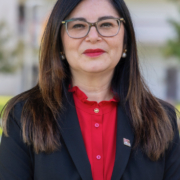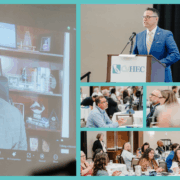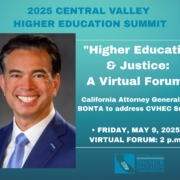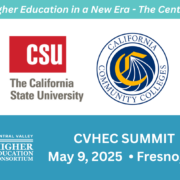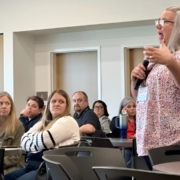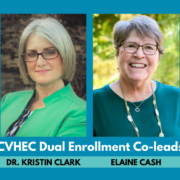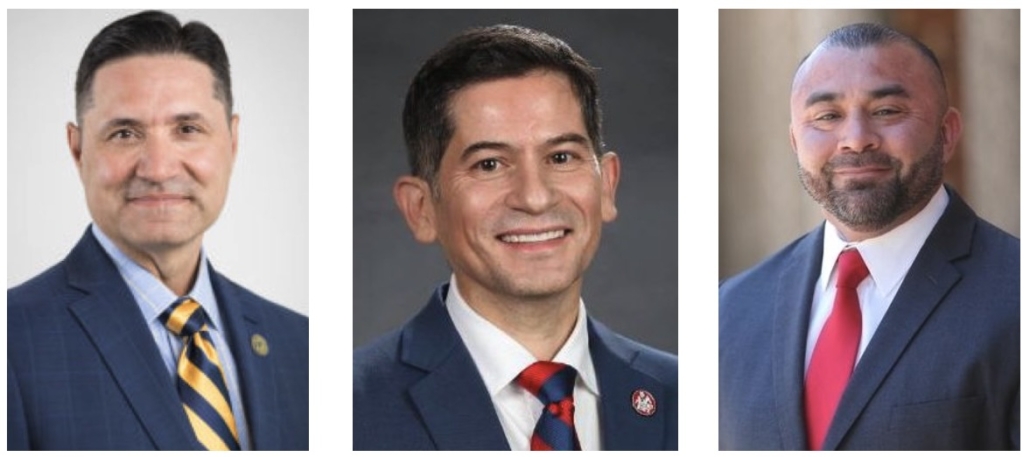
Reelected to the CVHEC Board of Directors Executive Committee for one-year terms that began Oct. 1: University of California Merced Chancellor Juan Sánchez Muñoz, Fresno State President Saúl Jiménez-Sandoval and West Hills Community College District Chancellor Robert Pimentel.
Chancellors Muñoz, Pimentel and President Jiménez-Sandoval get new three-year terms
Three Central Valley higher ed leaders were re-elected to new three-year terms on the executive committee of the Central Valley Higher Education Consortium Board of Directors effective Oct. 1, announced Dr. Benjamín Durán, CVHEC executive director.
Dr. Juan Sánchez Muñoz, chancellor of University of California Merced, who is currently serving a one-year term as chairperson for the board that began in January, was re-elected to the executive committee along with Fresno State President Saúl Jiménez-Sandoval and West Hills Community College District Chancellor Robert Pimentel. The previous three-year terms for all three expired Sept. 30.
The CVHEC Board of Directors consists of the chief executive officers of 28 institutions of higher education in the valley’s 10-county region that comprise the consortium membership. The executive committee conducts business on behalf of the board when it is not available, especially for timely or urgent matters, and sets the agenda for board business, Durán said.
Per CVHEC bylaws, each higher education segment has a set number of representatives on the committee who are elected by the full board of directors. Seven executive committee members serve three-year terms beginning in October the first year.
“The executive committee acts as a smaller, more agile governing body, often handling operational issues and strategic planning between full board meetings, and serving as a sounding board for CVHEC internal leadership,” Durán explained.
The full board meets quarterly with the next session being planned for an early December target date, said Ángel Ramírez, CVHEC associate director.
Executive meetings are also held four times a year prior to board meetings with the first meeting of the 2025-26 executive committee planned for early November at UC Merced where the committee will vote to fill the secretary, treasurer and chair position from among its membership, Ramírez said.
At the recent CVHEC board retreat in August, Chancellor Sánchez Muñoz welcomed the valey higher ed leaders and said about CVHEC’s next steps, “We need to work together to support our students. We’re here to create a vision for how we celebrate.” [
President Jiménez-Sandoval said, “Being reelected for three more years to the executive board of CVHEC is a tremendous honor, as it allows us to continue our noble work in our Valley. This continuity of leadership will allow us to be intentional about our resolve to harness the power of AI, build a strong pipeline between community colleges and four-year institutions, and promote the power of higher education.”
The membership of the 2025 CVHEC Executive Committee by segment with their terms noted is:
• CALIFORNIA STATE UNIVERSITIES (2)
President Saúl Jiménez-Sandoval, Fresno State (2025 –2028)
President Britt Rios-Ellis, CSU Stanislaus (2024 –2027)
• CALIFORNIA COMMUNITY COLLEGES (3)
NORTH – President Chris Vitelli, Merced College (2024 –2027)
CENTRAL – Chancellor Robert Pimentel, West Hills Community College District (2025 –2028)
SOUTH – President Brent Calvin, College of the Sequoias (2024 –2027)
• UNIVERSITY OF CALIFORNIA (1)
Chancellor Juan Sánchez Muñoz, UC Merced ( 2025 –2028)
• PRIVATE/INDEPENDENT (1)
President Andre Stephens, Fresno Pacific (2024 –2027)
California Attorney General Rob Bonta tells the CVHEC Summit 2025: “This is an all-hands-on-deck, all-tools-in-the-toolbox moment where everyone needs to rise up and push back against the attacks and make […]
Dr. Kristin Clark named to co-lead CVHEC dual enrollment strategies with Elaine Cash
Dr. Kristin Clark, chancellor-emeritus of West Hills Community College District (WHCCD), has joined the
Central Valley Higher Education Consortium core team as a consultant leading the development of a “Dual Enrollment Guide/Playbook of Best Practices” for Central Valley colleges, especially those serving students in rural areas.
 Dr. Benjamin Duran, CVHEC executive director, recently announced the appointment bringing the former chancellor out of retirement seven months after stepping away from her 30-year career in higher education that also included the presidency of West Hills College-Lemoore (now Lemoore College) and service on the CVHEC board of directors.
Dr. Benjamin Duran, CVHEC executive director, recently announced the appointment bringing the former chancellor out of retirement seven months after stepping away from her 30-year career in higher education that also included the presidency of West Hills College-Lemoore (now Lemoore College) and service on the CVHEC board of directors.
Dr. Clark will pair up with Elaine Cash, CVHEC grants coordinator and former superintendent of Riverdale Joint Unified School District who last month was named to co-lead CVHEC’s dual enrollment project.
“We are very fortunate that Dr. Clark was available and willing to join us for this very important project,” Duran said. “Her addition to the powerful CVHEC consulting team comprised of retired higher education and K12 leaders will be a benefit to the entire area.”
This week, Duran leads a CVHEC delegation to the 2025 California Dual Enrollment Equity Conference (Feb. 23-26) in Sacramento by the California Alliance of Dual Enrollment Partnerships, Career Ladders Project, and EdTrust–West.
CVHEC will present its Master’s Upskilling Project and Central Valley Math Bridge Project with College Bridge.
He said the Dual Enrollment Guide/Playbook is one of the priorities that has emerged from the Central Valley Dual Enrollment for Equity and Prosperity Task Force (CVDEEP) that CVHEC formed in 2019 with representation from the consortium’s 15 community college members in the valley’s 10-county region.
See the full story about Dr. Kristen’s new CVHEC venture in the upcoming March issue of the CVHEC newsletter.
Dr. Clark’s full bio
Elaine Cash bio
“Dual Enrollment in the Central Valley, Working Toward a Unified Approach for Equity and Prosperity.”

